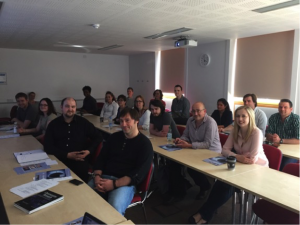On 16th and 17th June scientists from the Schools of Biosciences, Anthropology & Conservation as well as colleagues from Canterbury Christ Church University (CCCU) and the Royal Veterinary College (RVC) London got together to discuss their work. The mini-symposium kicked off the third area of focus of CISoR, non-human reproduction. Taken together the talks revealed the broad and fascinating scope of animal reproduction work going on at the University.
Animals from the simplest to the most complex were covered, beginning with the humble roundworm Caenorhabditis elegans. Jenny Tullet (Biosciences) asked the audience to consider C. elegans as a model for organismal ageing and development. She talked about different genetic pathways and processes that affect lifespan in several organisms and related these effects to effects on reproductive capability. Simon Harvey (CCCU) stayed with C. elegans in which he described his research identifying multiple regions of the genome that lower the ability of hybrids of different strains of C. elegans to reproduce. These are the types of effects that are important in the early stages of speciation.
Aside from worms, other invertebrates received less attention although Jim Groombridge (SAC) and Jenny Tullet did give insects a mention at some point. We quickly moved into vertebrate territory, bypassing fish and amphibians completely and looking at reptiles. Not any old reptiles however, Becky O’Connor described how she had used bioinformatic technology to look at chromosome evolution in dinosaurs. Darren Griffin (Biosciences) and Denis Larkin (RVC) also considered chromosome evolution but in birds and mammals, tracing chromosomal phylogenies and isolating regions of the genome prone to breakage during evolution.
Jim Groombridge and Simon Tollington stayed on an avian theme giving an account of their efforts to conserve Mauritius parakeets. Once one of the most endangered birds on the planet and threatened with an emerging infectious disease, Jim and Simon’s efforts have demonstrated that the negative effects of the disease outbreak on measures of reproductive fitness were surprisingly short-lived and associated with individuals that took supplemental food. Jim’s group is also investigating viral evolution in this system.
The laboratory mouse received quite some attention as Jenny showed how some of her worm work was applied to mice; this species was one of the many whose genomes had been aligned in Denis Larkin’s research. Peter Ellis (Biosciences) gave an overview of several ongoing projects, including the potential use of genetic methods in achieving efficient sex selection in agriculturally important species; and the epigenetic signals that tell cells with damaged DNA whether to repair the damage or to commit cellular suicide.
In a rare display of cross city University unity Katie Fowler joined forces with the Griffin lab (Claudia Rathje and Becki Gould) describing their collaborative work in the embryos of pigs and cattle. Using techniques first developed for humans they are adapting the technology to make food consumption and distribution a far more efficient and environmentally friendly process.
Finally we moved to primates – recently a new “living primates research group” was formed at the School of Anthropology and conservation (SAC) and Brandon Wheeler and Nick Newton-Fisher represented it. Brandon Wheeler’s “Female behavioural proceptivity functions as a probabilistic signal of fertility in a New World primate” was far more accessible than the title would suggest. He described his research using non-invasive monitoring of female reproductive hormones to study the mating strategies of wild capuchin monkeys. These studies have shown that female sexual signals convey information about the probability of ovulation, influencing male behaviour in a way that potentially allows females to both concentrate paternity in preferred males and confuse paternity among multiple males.
Nick gave an account of three recent publications studying two chimpanzee communities, a very “despotic” one in Uganda and a more egalitarian one in Tanzania. Nick has proposed a radical alternative to current thinking namely it is the females, not the males, who undergo significant roving in order to indulge in promiscuous mating. The poor males can’t keep up with all this activity so, instead maximize the number of mating opportunities by focusing their behaviour on trying to counter threats to health, fertility and reproduction, most frequently by grooming one another to reduce their stress levels.
The curry that the group enjoyed between the Tuesday and Wednesday sessions allowed for an opportunity to share common ground and explore future collaborations. It is clear that non-human research into reproduction is vibrant in the Kent area. The implications as models for humans, for conservation, food production and well as basic research into e.g. reproductive isolation are enormous.